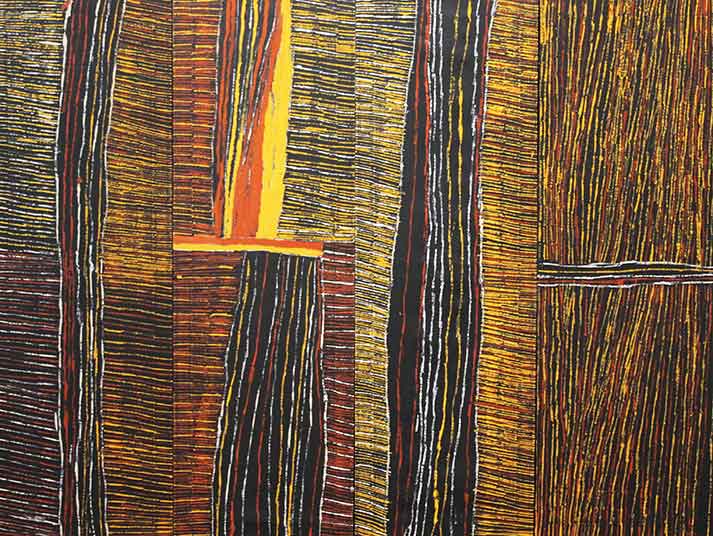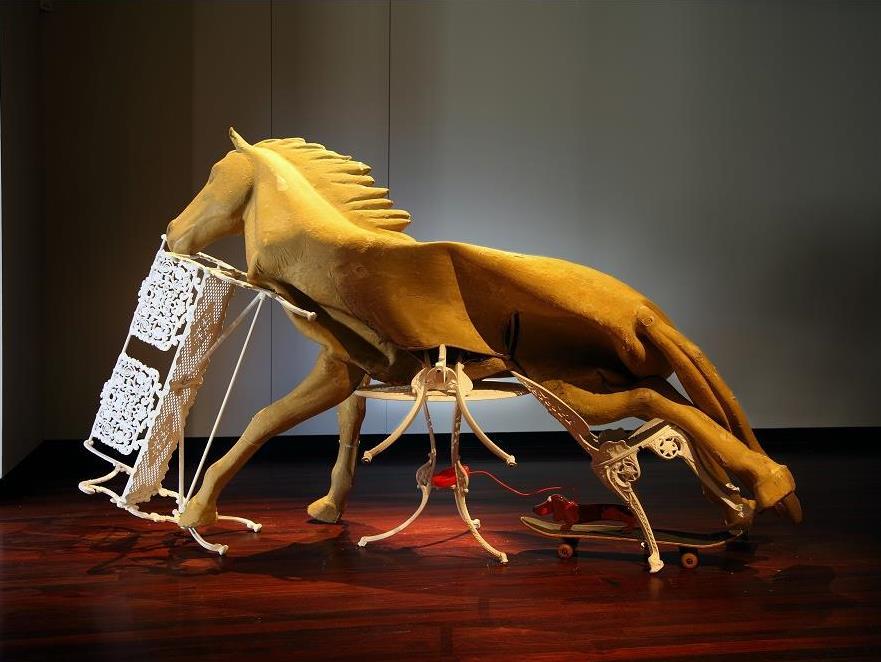Lou Hubbard, Dead Still Standing, 2014. Latex, polystyrene, Coalbrookdale patio chair, table & bench seat. Photo: Ben Cox. Winner GNAP15. Collection: Federation University Australia.
Most art prizes open the field to a broad group of entrants and then weed through the dross.
But the Guirguis New Art Prize (GNAP) uses the insight of curators to ensure a select group of artists, making participation an honour in itself.
GNAP’s consultative model invites key contemporary curators from select public galleries across Australia, to recommend artists for the prize. These artists are then invited to submit a proposal for shortlisting,
‘I seek the support of curators from around Australia within major public art institutions to suggest artists that are on the curators’ radar and who they think would be suitable for the prize,’ explained Shelley Hinton, Curator of Federation University Australia’s Post Office Gallery, Ballarat and curator of the Guirguis New Art Prize.
‘A stipend is provided for each artist after their selection as a finalist as assistance for materials, accommodation and freight and the development of their ideas,’ said Hinton.
‘Artists can submit two types of proposals – a work created in the last twelve months or a new work.’
Click here for more information
The biennial prize exhibition is restricted to a maximum of 16 contemporary artists, offering an exciting snapshot of what is happening in contemporary art in Australia. This year there are a total of 14 finalists including Abdul Abdullah, Joel Arthur, Erin Coates and DAMP.
There is no age restriction for artists and so far many important artists have created new exciting work for the Prize.
‘The word “new” in GNAP, doesn’t necessarily mean new artists. The artists can be advanced in their art practice. It is more to do with “new” contemporary art practice, encouraging new ideas, new materials, new approaches, new technologies and modes of working,’ said Hinton.
‘Initially I was thinking technology would play a major part in the Prize, but then I decided I would rather allow artists to present work in existing materials and new technologies –a hybridized version of new and existing formats and materials.’
.jpg)
Ash Keating West Park Proposition, 2012. 3 channel synchronised HD digital video. 16:9, PAL colour, stereo sound. Duration: 2 minutes 14 seconds. Winner: GNAP13. Photo: Greta Costello. Collection: Federation University Australia. Winner: GNAP13 Collection: Federation University Australia
The Prize is generously funded by local Ballarat philanthropist and surgeon Mr Mark Guirguis who is also a Board member of the Art Gallery of Ballarat and Chair of the Art Gallery of Ballarat Foundation.
GNAP seeks to highlight the significance of contemporary art and ‘living’ culture in the regional city of Ballarat.
Now in its third iteration, GNAP is administered by FedUni and presented in association with the Art Gallery of Ballarat, held at the 2 sites – FedUni’s Post Office Gallery and the Art Gallery of Ballarat, from 25 March – 14 May 2017.
A regional drawcard
By bringing some of Australia’s most exciting contemporary artists to the regional location of Ballarat, GNAP creates an opportunity for local audiences to see new inspiring exciting works of art. The Prize also attracts local, regional and interstate visitors to Ballarat to appreciate the Prize and other cultural assets of the city.
‘The work of these artists wouldn’t normally be seen in Ballarat and usually only exhibited in major cities so its fantastic that the Prize is able to allow that to happen. For regional audiences it is a fascinating encounter and for Melbourne audiences the Prize is accessible and an easy distance from the city. As a national Prize, curators and artists are able to gain a snapshot of contemporary artists from across the nation who may be little known in other states,’ said Hinton.
Because of the calibre of GNAP artists, the Prize is now on the national cultural radar of curators and other gatekeepers in the arts. As with all exhibitions, artists are provided with greater exposure but GNAP is unique is being a truly national Prize, having represented artists from each state and territory in Australia.
Participating artists in GNAP gain valuable exposure, which can lead to further opportunities, acquisitions and exhibitions.

Conrad Tipungwuti, Pakitiringa (Rain), 2014 natural ochres on linen 180 x 240cm. Collection: Art Gallery of Ballarat
Following Tiwi Islands artist Conrad Tipungwuti exhibited his work Pakitiringa, 2014 in GNAP15, his work was acquired for the Art Gallery of Ballarat’s Permanent Collection.
Hinton said; artists represented in GNAP are inadvertently assisted in building a greater profile as well as being on the radar of curators and directors which is a great outcome for the finalists.
GNAP17 is soon to be presented at the Post Office Gallery, Arts Academy, Federation University Australia and the Art Gallery of Ballarat.
Open 10am to 5pm daily. Free entry. For more information visit federation.edu.au/gnap





